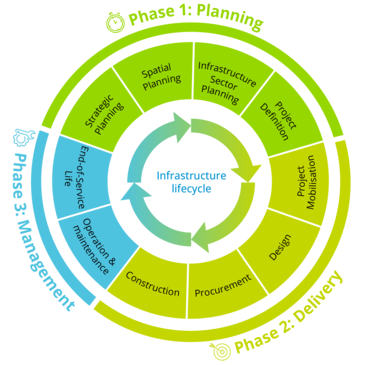Phases and Stages
EnABLE assesses the entire infrastructure lifecycle across three phases and ten stages:

|
Each phase is broken down into stages which represent the processes that are required to develop and implement that particular phase. Explore the Phases and stages in the scorecards below:
It is the process by which a government determines comprehensively future objectives and how to get there. It is a deliberate attempt to produce changes. Strategic plans often look at a medium-term period of five years and a long-term (~30 years) perspective, also called a Vision
It refers to approaches that define the spatial organisation of people, activities, institutions and infrastructure at various scales. It is concerned with identifying long- or medium-term objectives and strategies for territories, dealing with land use and physical development and coordinating sectoral policies such as transport, housing, agriculture and environment.
It is the process of identifying service delivery needs and the planning of infrastructure construction and renovation for a particular sector or all sectors. It is aligned with strategic and sector plans. It also includes securing funding for project pipelines.
It refers to the process of identifying, prioritising and defining infrastructure projects that respond to infrastructure service delivery needs, under the scope of the infrastructure sector plan. It involves undertaking feasibility studies, environmental and social impact assessment and climate risk assessment, as well as identifying and securing funds.
It refers to how resources are mobilized to deliver an identified infrastructure project, ensure quality and that the project meets sustainability, resilience and inclusion targets. It involves determining the project implementation plan, including scope, time frame, budget and output quality criteria.
It translates the project programme into drawings and technical documents necessary for the procurement and construction phases. They define layout, materials and construction techniques following design or building codes to ensure long-term operational performance, reduced maintenance needs and safe and functional services to end-users. It also involves the approval of design submissions and the permitting process.
It refers to how infrastructure services, labour and materials are sustainably procured for all design, construction, operation and maintenance and service lifecycle adaptation and end-of-life stages to ensure that quality assets are delivered, managed and have a long operational life with minimal costs. It involves defining bidding documents, tender evaluation and management of contracts.
It is when infrastructure assets are built according to design and procurement documents, while ensuring quality for long operational life, health and safety and minimal impact on local communities and environments. This stage also includes construction site management, planning, expenses follow-up and final inspection
It refers to the period when the infrastructure is in use. The infrastructure asset is maintained and monitored to ensure operational performance, with a particular focus on critical assets. The infrastructure can also change use and/or go through a renovation.
It refers to mechanisms for renovation, retrofitting, repurposing and decommissioning infrastructure. These activities are essential to maximize infrastructure asset investment by finding ways for the assets to remain functional and adaptable in alignment with user needs. When determined that the asset is no longer able to deliver a service, it should be responsibly dismantled with its materials being recycled to support new asset development.

